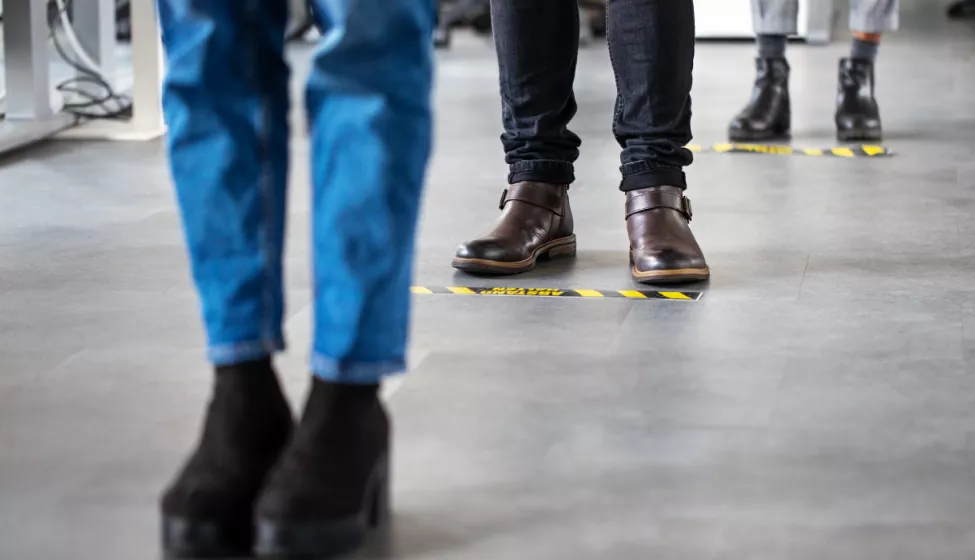January 14, 2021
During the winter months, it is important to continue to practice the 3 W's (washing hands frequently, watching your distance, and wearing your mask) to reduce the spread of the COVID-19 virus.
The World Health Organization (WHO) has confirmed that COVID-19 virus transmission can occur through respiratory droplets generated by expiratory events, such as coughing, sneezing, laughing, talking, or breathing. Larger respiratory droplets typically fall to the ground or onto nearby surfaces, whereas liquid droplets smaller than 100 μm often evaporate.
As the water from smaller droplets evaporates, the biological residue becomes concentrated in the form of a bioaerosol. These aerosols can remain suspended in the air for minutes to hours and can travel far from the source on air currents, spreading disease. This transmission pathway may be more prevalent in colder winter months, when drier air helps promote aerosol formation and dispersion.
For months, owners and operators of public facilities and workspaces here in the United States have followed Centers for Disease Control and Prevention recommendations focused on maintaining a six-foot distance between patrons/employees and disinfecting common surfaces. While these efforts remain critical, those responsible for public facilities can consider additional safety measures, such as improvement of humidity levels and air exchange rates, that could reduce the formation and dispersion of aerosols and reduce the likelihood of potential exposure to COVID-19.
How Temperature and Humidity Affect Aerosol Dispersion
Aerosol formation and dispersion are affected by the initial droplet size from an expiratory event and the evaporation rate during the lifetime of the droplet. Both humidity and temperature in turn affect rates of aerosol evaporation.
Lower-humidity environments, typical during the winter season, lead to faster droplet evaporation rates.
Consequently, a larger fraction of the droplet population from an expiratory event may become aerosolized and remain suspended longer during low-humidity winter conditions.
For indoor spaces, seasonal changes in temperature are modest; however, changes in humidity can be more substantial, and the arrival of drier weather means more droplets may become aerosolized and remain suspended in the air. While cloth face coverings are an important tool in preventing COVID-19 virus spread, they do not necessarily prevent inhalation of aerosolized particles. It therefore stands to reason that as we head into the drier environment of winter, consideration must be given to the potential increase in risk of contracting the disease in indoor environments.
Fortunately, owners and operators can mitigate the formation of aerosols by controlling the humidity in their facilities. When a space is humidified, the respiratory droplets generated from sneezing, talking, and laughing evaporate less quickly. This lowers the rate of aerosol formation and dispersion and may reduce the likelihood of airborne virus transmission.
Improving Air Exchange Rates
Aerosol dispersion and accumulation are also affected by air exchange rates, or how many times per hour the air in a given space refreshes. The lower the air exchange rate — lower air exchange rates are often used in colder weather — the more contaminants can accumulate. The higher the exchange rate, the more air turnover or fresh air, and the less contaminants can accumulate.
Owners and operators can consider reducing contaminant accumulation by increasing air exchange rates indoors. Different heating systems vary in their ability to control the introduction of fresh air. Oftentimes, when forced hot air systems supply hot air to a space, they also exhaust air from the space and may be configured to introduce and control the amount of fresh air with relative ease.
In contrast, spaces heated with radiant heat panels and hot water or steam radiators are less equipped to control air exchange rates and tend to rely on natural circulation associated with the infiltration of fresh air through windows, doors, and porous walls. Older and smaller retail spaces, businesses, and homes tend to be more likely to be heated by radiator systems, while modern buildings are more likely to be heated by forced hot air systems.
Current ASHRAE Guidance
For further guidance on how to operate their building's mechanical systems to minimize contamination accumulation and transmission, owners and operators can refer to the COVID-19 response guidance offered by the American Society of Heating, Refrigerating, and Air-Conditioning Engineers (ASHRAE). The guidance provides practical information and recommends specific humidity levels, air exchange rates, and filtration efficiencies to mitigate the spread of infectious aerosols through the HVAC system. The guide provides recommendations for commercial buildings, educational facilities, residential buildings, and healthcare facilities.
For commercial buildings, specific key recommendations include the following:
- Maintaining the relative humidity of a space between 40 and 60%.
- Increasing the outside air for ventilation as much as the HVAC system can accommodate. If there are significant energy impacts, use the minimum outside air as required per ASHRAE 62.1 with a MERV-13 filter.
- Flush the building with the maximum outside air flow for two hours before and after occupied times or achieve three air-changes of outside air in the space.
While greater physical distance may reduce the risk of spread of COVID-19, a conscious application of the 3 W's in addition to optimizing the air handling system are all important in reducing the likelihood of transmission of COVID-19.
How Exponent Can Help
Exponent's multidisciplinary team of mechanical engineers, thermal scientists, and HVAC experts has studied complex air flow patterns and droplet and particle interactions in air flows for over 40 years. Our thermal fluid scientists are well versed in the fundamentals of computational fluid dynamics (CFD) and can help owners and operators of public spaces evaluate air currents and aerosol dispersion in their facilities. An example of such a study is depicted below for a patient waiting room.


